Instrumental Duet,Piano B-Flat Clarinet,Cello,Instrumental Duet,Piano - Level 5 - Digital Download SKU: A0.1284045 Composed by Spiritual. Arranged by Maria Thompson Corley. 21st Century,Chamber,Christian,Sacred,Traditional. 17 pages. Maria Thompson Corley #875217. Published by Maria Thompson Corley (A0.1284045). âCrossing Jordanâ grew out of my daughter Kianaâs surprise request that I arrange a spiritual for voice, piano and cello for her senior recital. She received a degree in commercial music the year before COVID shut everything down, at a time before climate change made blizzards an anomaly here in Central PA. As a result, snow days still existed. I spent one of them doing the first draft of âDeep River,â her favorite.Later, I decided that if singers engage a cellist for a concert, they might like to program more than one piece for them, so I chose two more water-themed spirituals to complete the set. âHis Name So Sweetâ is a more meditative version of the song than Iâve generally heard. I wanted the piano, cello, and briefly the voice to imitate the fountain in the text. The mood is ecstasy, resulting from the fundamental change that baptism is meant to create. âDeep Riverâ also includes âMichael Row The Boat Ashoreâ and âThe Water Is Wide.â The latter isnât a spiritual, however, taken together the message is that the river is deep, the water is wide, but with (the Archangel?) Michaelâs help, Jordan can be crossed. âWade in the Waterâ is one of the most well-known spirituals. I focus on the idea of escaping enslavement: the opening is quiet, furtive, maybe even nervous. The Moses in the text can be understood to be Harriet Tubman, who might urge escapees to wade in the water so pursuing dogs couldnât follow their scent. In my mind, the ending symbolizes that the party has vanished, never to be enslaved again.The first instrumental version of âDeep Riverâ was for trumpet and piano, performed by my sister, Alicia Thompson, and her son, Justin Griffin, during a church service in Atlanta shortly after I arranged it. After hearing a recording, I took borrowed her idea of adding a repeat (which she did to allow enough time for the ushers to take up collection). The clarinet, cello and piano version was premiered by the Isosceles Trio (Doris Hall-Gulati (clarinet), Sara Male (cello), and me (piano)). When Naima Burrs, violinist and conductor of the Petersburg Symphony, asked if I had any pieces for trio, I created a version for violin, piano and cello. The flute/piano/cello version may have been performed, but if so, nobody has mentioned it to me.
